Day 1, Sessions, Monday 26 October
Conference Opens Big With a Focus on the Americas
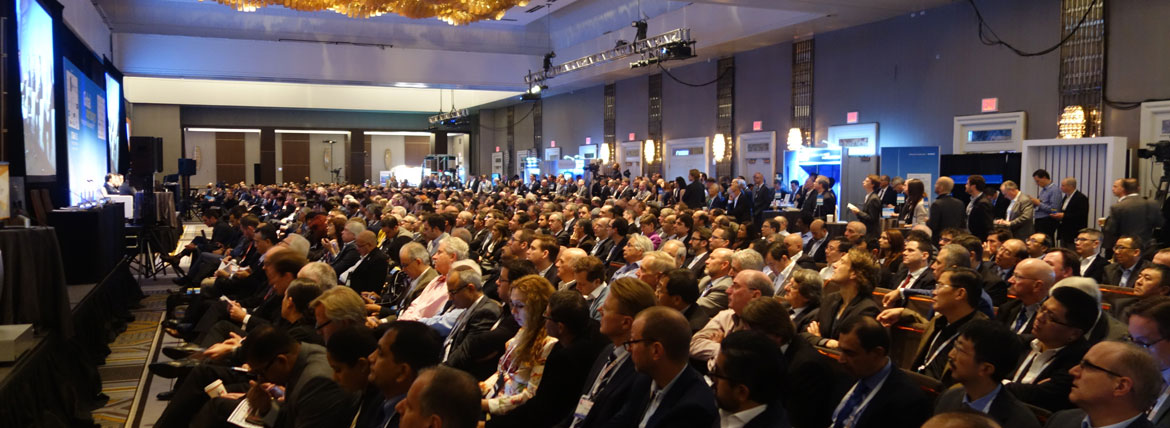
The first day of the CTBUH 2015 Conference represented one of the most high-profile days in CTBUH conference history, with back-to-back sessions featuring some of the most prominent figures in the design, development, planning, engineering, and construction of tall buildings worldwide. Even before sessions began, the atmosphere at the Grand Hyatt in New York was one of expectant energy. All around, exhaustive preparations from the previous day were validated in the overall polish of the exhibition suites, poster exhibits, host rooms, and program sessions.
VIP Photo Encapsulates Landmark Conference Crowd
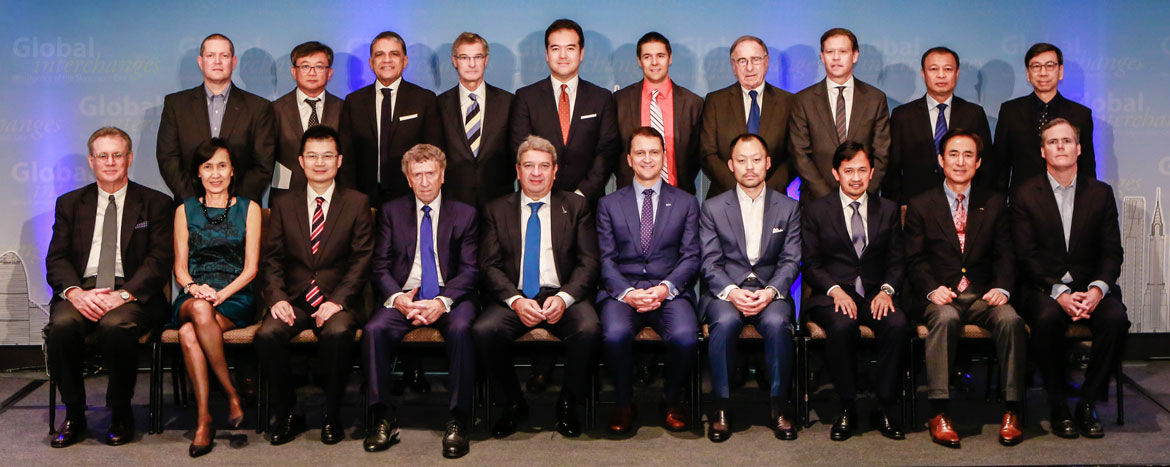
2015 Conference VIPs from left to right: Top row: Robert Pratt, Tishman Speyer; Wai Ming (Thomas) Tsang, Ping An Finance Center; Joseph Moinian, 3 Hudson Boulevard; Jay Cross, Hudson Yards; David Malott, CTBUH Chairman / KPF; Antony Wood, CTBUH; Harry Macklowe, 432 Park Avenue; Ric Clark, Manhattan West; Tengku Mahmud, KL118 Tower; Wing Ip (David) Ho, Tianjin Chow Tai Fook Binhai Center. Bottom row: James Robinson, Hongkong Land; Irene Wai, International Commerce Centre; Joseph Chou, TAIPEI 101; Irvine Sellar, The Shard; Mounib Hammoud, Kingdom Tower; Alexander Durst, One World Trade Center; Sorapoj Techakrairsi, MahaNakhon; Datuk Hashim Wahir, Petronas Towers; Byung Yong Noh, Lotte World Tower; John Kessler, Empire State Realty Trust
The day started with a VIP photo session that was made up of a number of developers of many of the world’s most significant tall building projects. CTBUH Chairman David Malott and Executive Director Antony Wood joined 18 of these VIPs in front of the 2015 Conference Skyline, a collection of 50 buildings that are challenging current notions of tall building design in terms of form, performance, engineering, or programming.
View more details on the VIPs.
Opening Plenary – A Panel to Remember
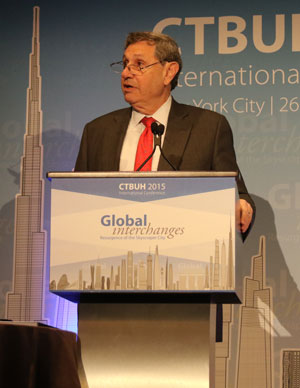
Carl Weisbrod, Chairman of the City of New York Department of City Planning
The Opening Plenary commenced with warm words of welcome from CTBUH Chairman David Malott, who reflected on the true meaning of the words Global Interchanges. “It means the flow of capital, of materials, of ideas, and technologies across the world – so that a project in New York is not just a New York project anymore, but it represents part of the greater world,” Malott explained.
Next, a spirited opening keynote speech was given by Carl Weisbrod, Chairman of the City of New York Department of City Planning. With a candid fervor and clear passion for the urban future of The Big Apple and cities abroad, Weisbrod emphasized the critical role played by the numerous industry professionals present in the room, noting, “All of you here today have a hand in shaping the skylines of the great and growing cities throughout the world; you create dynamic feats of architecture and engineering, and you develop innovative financing mechanisms and partnerships with government. These buildings twist, turn, shine, glimmer, and shoot skyward and inspire people with talent and energy to come to cities with the promise of opportunity and intellectual excitement.” Brief and to the point, Weisbrod’s presentation set the scene for the following panel discussion chaired by Executive Director Antony Wood, which featured four of the most active and influential developers in New York: Gary Barnett, President, Extell; Ric Clark, CEO, Brookfield Properties; Joseph Moinian, Founder & CEO, Moinian Group; and Larry Silverstein, Chairman, Silverstein Properties. Having these four individuals on stage at the same time was in itself a landmark moment. Panelists provided a rare glimpse of the oft-shrouded thought processes behind some of the city’s preeminent skyscraper projects.

Opening Panel (left to right): Gary Barnett, President, Extell; Ric Clark, CEO, Brookfield Properties; Joseph Moinian, Founder & CEO, Moinian Group; and Larry Silverstein, Chairman, Silverstein Properties
The global theme of the conference was clearly illustrated when Wood asked the panelists to name some of the biggest changes in skyscraper development since the recent economic recovery. Barnett asserted, “The whole world really wants to come to New York City and in the past five years we’ve seen a resurgence of investment…everybody is realizing that the United States is very stable politically and economically, so we’re seeing a tremendous inflow of capital in both debt and equity.” Ric Clark echoed this point, but added that New York City remains competitive with other major global cities in terms of property value. “In addition to being a safe haven it’s actually a pretty good value proposition,” he surmised.
Touching on the treatment of debt since the recession, Moinian mentioned, “The credit market came back with much better discipline…and came back with funding for making sure that a project is more financially viable.” Finally Silverstein concluded to the panel, “One of the things we’ve seen is that the degree of turmoil that exists in certain parts of the world has, if anything, increased the flight to safety for capital – global capital. And certainly, as has been stated by my colleagues, New York and the United States is the desirable location for this capital.”
New York Theme Resounds Throughout Conference Sessions
The day continued with a jam-packed schedule comprising 15 sessions and robust programs in an equal number of Host Rooms. In Session 1e and Session 3e, discussions reverberated from the Opening Plenary on the state of skyscraper development in the New York, with notable presentations from the likes of Alexander Durst, Chief Development Officer, The Durst Organization; Harry Macklowe, Chairman, Macklowe Properties; James von Klemperer, President, Kohn Pedersen Fox Associates; and Carol Willis, President, The Skyscraper Museum.
Alexander Durst imparted many of the lessons that he and the Durst Organization have learned in the process of integrating green technologies into their properties, and presented his thoughts on how tall buildings can help realize the city’s goal of reducing its greenhouse gas emissions by 80%. “We can’t get to an 80% reduction simply by making our buildings more energy conservative, we have to do on-site energy production if we are ever going to get close.”
Urban Issues and Public Space at the Forefront
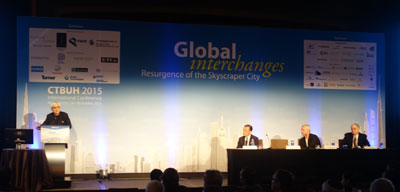
Rafael Viñoly (left), Lead Designer/Principal, Rafael Viñoly Architects
The concept of public space and other urban issues were well represented throughout the day, with sessions that explored how tall buildings can provide meaningful social opportunities for our cities, a topic that is particularly vital for the North American region, which has historically undermined social design considerations in the face of rapid urban expansion. Session 1c in the Urban Issues Room opened with presentations drawing attention to the need for connecting building users with vegetation, public spaces, and new types of urban landscapes, with presentations from Rafael Viñoly, Lead Designer/Principal, Rafael Viñoly Architects; Richard Cook, Partner, COOKFOX Architects; and James Goettsch, CEO & Partner, Goettsch Partners.
Rafael Viñoly presented his philosophy of tall buildings as public assets, drawing upon three of his recent projects that attempt to advance the dialogue between tall buildings and their public: 20 Fenchurch St., London; Samsung Jongno Tower, Seoul; and Mahler 4, Amsterdam. Viñoly stated that these projects are informed by his belief that urban space is more than a blank plaza that happens to surround a tall building. Instead, he surmised that tall buildings must encourage a more dynamic interplay, like that offered by the winding exterior staircases and greenroofs at Mahler 4 or the public sky garden found at the top of 20 Fenchurch St, which have each become the most visible and pronounced aspects of their respective projects.
The New Normal: Retrofit and Upgrade
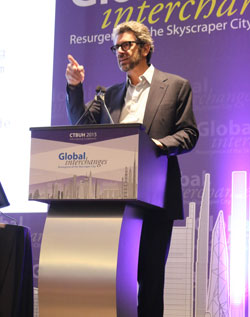
Anthony E. Malkin, Chairman & CEO, Empire State Realty Trust
The looming threat of an aging tall building stock in danger of obsolescence has made retrofit and upgrade initiatives bubble to the surface of industry activity over the past decade. As such, Anthony E. Malkin, Chairman & CEO, Empire State Realty Trust, presented the comprehensive energy upgrade initiative that was undertaken for the Empire State Building in Session 2e. By selecting eight upgrade initiatives, including the refurbishment of all 6,514 windows and the replacement of air handling units, the iconic tower has reduced thermal and electric energy consumption by 38.4 percent, elevating what was once the world’s tallest building to one of the most energy efficient. “When we looked at the sustainability piece of the Empire State Building it became more about energy efficiency, and became about using the convenient power of the building and the attention it could get to chronicle, document, and prove that energy efficiency could be at the root of any building retrofit,” Malkin remarked.
In a similar vein, Michael Adlerstein, Assistant Secretary General, United Nations Capital Master Plan, recounted the renovation process for the United Nations Secretariat Building, a mid-century Modern icon that was refitted with new elevator systems and mechanical infrastructure, new fire protection systems and code upgrades, disabled-access compliance, and a new floor planning diagram. Leslie Shepherd, Chief Architect, U.S. General Services Administration, subsequently overviewed the modernization efforts for the Edith Green-Wendell Wyatt Federal Building, which received a complete mechanical upgrade, a seismic retrofit, full interior rehabilitation, and a brand new building envelope with a distinctive shaded façade. Both of these important projects were recognized in the 2014 CTBUH Awards Program, with the UN Secretariat being a Finalist for the Americas and Edith Green-Wendell Wyatt Federal Building becoming the 2014 Best Tall Building Americas.
The Next Generation of High-Rise Performance
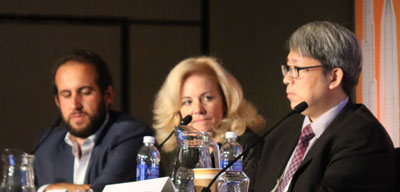
Left to right: Michael Rudin, Vice President, Rudin Management Company, Inc.; Kelly Romano, President, Intelligent Building Technologies, United Technologies Corporation; Patrick Leung, Sun Hung Kai Properties, International Commerce Centre
Given the great advancements that have been realized in digital networking and computing technology, the door has been opened for creating smarter, more responsive, skyscrapers. In Session 3d, Building Performance & Operation, delegates heard from three colleagues at the cutting edge of intelligent building systems and performance reporting: Patrick Leung, who represented the winner of the CTBUH 2014 Performance Award, Sun Hung Kai Properties for the International Commerce Centre (Hong Kong); Michael Rudin (Vice President, Rudin Management Company, Inc.), who overviewed the Di-BOSS platform installed in several buildings throughout New York City; and Kelly Romano (President, Intelligent Building Technologies, United Technologies Corporation), who gave a general overview of the possibilities for integrated and intelligent buildings.
Kelly Romano in particular highlighted the importance of the topic by succinctly summarizing the benefits of intelligent building systems, citing a 50% increase in employee sick days when buildings have inadequate ventilation and a performance reduction of 11 to 23 percent when indoor carbon dioxide levels range from 600 to 1,000 ppm. Romano added, “Research and statistics certainly make a clear and compelling case for this community to accelerate the deployment of intelligent technologies and building management to new and existing buildings.”
Panel Discussion: Investments Without Borders
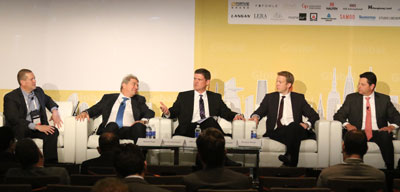
Left to right: Robert Pratt, Managing Director, Tishman Speyer; Mounib Hammoud, CEO, Jeddah Economic Company; Matthew Richards, International Director, JLL; John Jacobsson, Executive VP, Related Companies; and Richard Wood, CEO, China Construction America/Plaza Construction
Central to the theme for this year’s Conference is the intensification of transnational investment in skyscraper developments. Economic downturns aside, high-rise real estate is generally seen as a sound investment on an international level, particularly in markets like New York City, where prices are almost certain to continue increasing in value. To tackle this topic head-on, a group of real estate, construction, and investment professionals gathered for the Session 3b panel discussion entitled Global Interchanges: Investments Within and Across Borders.
The discussion was chaired by Robert Pratt, Managing Director, Tishman Speyer, and panelists included Mounib Hammoud, CEO, Jeddah Economic Company; Matthew Richards, International Director, JLL; John Jacobsson, Executive VP, Related Companies; and Richard Wood, CEO, China Construction America/Plaza Construction. Jacobsson made an interesting point that recalled earlier discussions in the Opening Plenary, stating, “In addition to currency, global volatility in all financial assets is another factor to consider. It points out why places in the US and the UK are seen as these practical places to invest in property.”
CTBUH Receives 2015 Henry C. Turner Prize for Innovation in Construction
 During the lunch break, Chairman David Malott had the pleasure of accepting the 2015 Henry C. Turner Prize and a giant check for $25,000 from Turner Construction Company on behalf of the Council on Tall Buildings and Urban Habitat. The prize is awarded annually to recognize an advancement or high achievement in the process of construction, an innovative methodology, and/or exemplary leadership. The Council was selected to receive this award for its long history of leadership in facilitating research and promoting education, as well as for its contributions to the building industry. Upon receiving the award from Turner President & CEO Peter Davoran, Chairman Malott said, “What we will use this fund for is to start an initiative to catalogue and measure technologies on the leading edge of tall building design. This will be organized into a publication for release in one to two year’s time.”
During the lunch break, Chairman David Malott had the pleasure of accepting the 2015 Henry C. Turner Prize and a giant check for $25,000 from Turner Construction Company on behalf of the Council on Tall Buildings and Urban Habitat. The prize is awarded annually to recognize an advancement or high achievement in the process of construction, an innovative methodology, and/or exemplary leadership. The Council was selected to receive this award for its long history of leadership in facilitating research and promoting education, as well as for its contributions to the building industry. Upon receiving the award from Turner President & CEO Peter Davoran, Chairman Malott said, “What we will use this fund for is to start an initiative to catalogue and measure technologies on the leading edge of tall building design. This will be organized into a publication for release in one to two year’s time.”
15 Host Rooms Give Conference Program Acute Focus
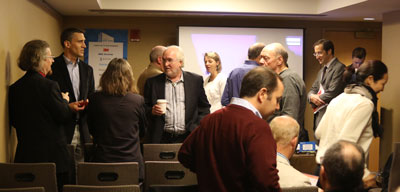 In addition to the main program of the Conference, 15 Host Rooms were organized by Platinum and Silver level sponsors, who held their own series of presentations, seminars, meetings, networking lunches, and other events. Open to the public and free to attend, these rooms were highly successful and focused on topics like construction, structural engineering, façades, vertical transportation, demolition, fire/life safety, architectural design, as well as activities in various regions of the world. Not only did the Host Room model diversify the amount of content available at the overall Conference, but truly allowed members and sponsors to share in the endeavor of disseminating information on tall buildings and steering conversations in the industry with an eye toward the future.
In addition to the main program of the Conference, 15 Host Rooms were organized by Platinum and Silver level sponsors, who held their own series of presentations, seminars, meetings, networking lunches, and other events. Open to the public and free to attend, these rooms were highly successful and focused on topics like construction, structural engineering, façades, vertical transportation, demolition, fire/life safety, architectural design, as well as activities in various regions of the world. Not only did the Host Room model diversify the amount of content available at the overall Conference, but truly allowed members and sponsors to share in the endeavor of disseminating information on tall buildings and steering conversations in the industry with an eye toward the future.
Day 1 Ends on High Note With Networking Reception at Empire State Building

The Networking Reception at the Empire State Building provided a fitting end for a day focusing on the resurgence of skyscraper activity in the Americas. Graciously hosted by Empire State Realty Trust and sponsored by Schindler, the reception was located on the 80th-floor of the tower, offering fantastic views of Midtown and the expansive region beyond. The owner of the building, Anthony E. Malkin, welcomed guests, stating, “I’m appreciative of the Council for making the effort to have an event here and I’m really appreciative of being able to share what we have done here at this building and what we continue to do.” An evening of music, drinks, and conversation was made even better by an exclusive tour of the observation deck, which stood as the world’s highest from 1931 to 1973. Here, attendees reflected on how far the city, the United States, and North America have come since this landmark building was completed. If the themes covered throughout the day were any indication, the day of the skyscraper is not over in this region, in fact, its re-emergence may only be beginning.
Scenes From the Day

